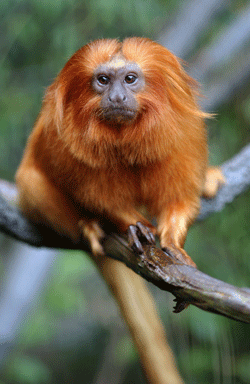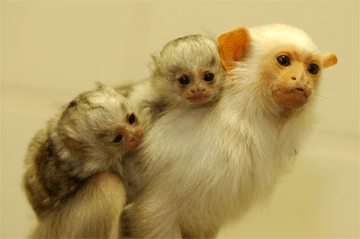Human medical tests keep some of the world’s smallest monkeys healthy
Testing on humans for animal medications?
Jeremy Hance, mongabay.com
August 6, 2008
Medical advances for humans have largely been dependent on other species: deriving chemical compounds from plants, employing molds for vaccines, or testing drugs on mammals. However, in an intriguing twist the Wildlife Conservation Society has adapted a test used on humans for primates in the Bronx Zoo.
The non-invasive test measures the amount of iron in the patient to see if their body contains too much. It is currently being used on some of the world’s smallest monkeys, the tamarins and marmosets. These little monkeys live in the tropics of Central and South America. Many of the species are endangered due to habitat loss and the pet trade.
 Golden lion tamarin (photo credit: Dennis DeMello/Wildlife Conservation Society) |
“With this test, we can monitor the iron levels in marmosets and tamarins for early identification of individuals that may be predisposed to develop hemosiderosis, an overload of iron in the body, despite the low iron diet that has been fine-tuned to the unique requirements of these species,” said Dr. Kristine Smith of the Wildlife Conservation Society and lead author on the paper.
According to the paper, tamarins and marmosets absorb iron very efficiently, making them especially susceptible to high levels. The test has become a regular fixture for these diminutive primates’ checkups at the World Conservation Society’s Bronx Zoo. If an animal is seen to have high levels of iron, their diet is changed to lower the body’s iron.
Dr. Smith stated that the test wasn’t just used on the marmosets and tamarins: birds, rhinos, lemurs, and bats have had their iron levels measured at the zoo.
The study, “Hematologic Iron Analyte Values as an Indicator of Hepatic Hemosiderosis in Callitrichidae”, is available in the recent edition of The American Journal of Primatology.

Silvery marmoset (photo credit: Julie Larsen Maher/Wildlife Conservation Society







